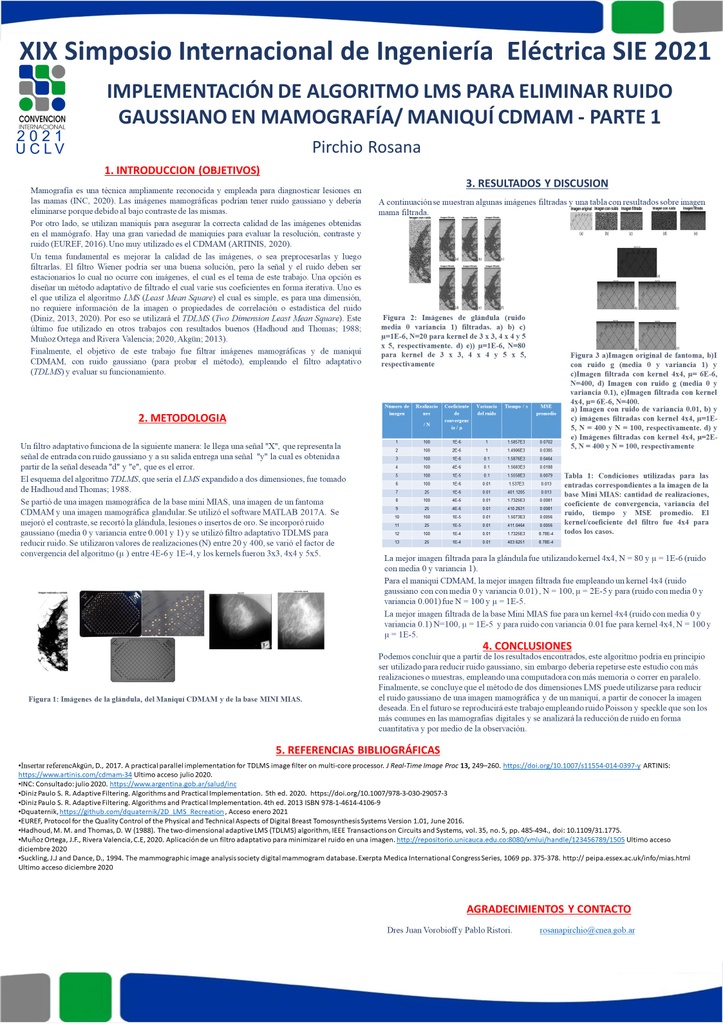Executive Secretary

19th International Symposium of Electrical Engineering
SIE 2021

Abstract
Mammography is a recognized technique for the early diagnosis of benign or malignant breast lesions. In mammographic images, the contrast is very low and noise can mask a finding. The objective of this work was to study the reduction of Gaussian noise in mammographic and phantom images.
The starting point was a mammographic image of the mini MIAS base, an image of a CDMAM phantom and a glandular mammographic image. The MATLAB 2017A software was used. The contrast was improved, the gland, lesions or gold inserts were cut out. Gaussian noise was incorporated (mean 0 and variance between 0.001 and 1) and an adaptive 2D LMS filter (TDLMS) was used to reduce noise. Realization values (N) between 20 and 400 were used, the convergence factor of the TDLMS algorithm was varied between 4E-6 and 1E-4, and the kernels were 3x3, 4x4 and 5x5.
The best filtered image with lesions was for kernel 4x4, N = 100, µ = 1E-5, noise variance 0.1 and kernel 4x4, N = 100 and µ = 1E-5, noise variance 0.01. For the phantom it was kernel 4x4, N = 100 and µ = 2E-5, noise variance 0.01, and it was N = 100 and µ = 1E-5 for noise variance 0.001. For the gland it was kernel 4x4, N = 80, µ = 1E-6 (noise variance 1). It is concluded that the 2D LMS method can be used to reduce the Gaussian noise of a mammographic image and a phantom, knowing the desired image.
Resumen
Mamografía es una técnica reconocida para el diagnóstico precoz de las lesiones benignas o malignas en las mamas. En las imágenes mamográficas el contraste es muy bajo y el ruido puede enmascarar algún hallazgo. El objetivo de este trabajo fue estudiar la reducción del ruido gaussiano en imágenes mamográficas y de fantoma.
Se partió de una imagen mamográfica de la base mini MIAS, una imagen de un fantoma CDMAM y una imagen mamográfica glandular. Se utilizó el sofware MATLAB 2017A. Se mejoró el contraste, se recortó la glándula, lesiones o insertos de oro. Se incorporó ruido gaussiano (media 0 y variancia entre 0.001 y 1) y se utilizó filtro adaptativo 2D LMS (TDLMS) para reducir ruido. Se utilizaron valores de realizaciones (N) entre 20 y 400, se varió el factor de convergencia del algoritmo TDLMS entre 4E-6 y 1E-4, y los kerneles fueron 3x3, 4x4 y 5x5.
La mejor imagen filtrada con lesiones fue para kernel 4x4, N=100, µ = 1E-5, variancia de ruido 0.1y kernel 4x4, N = 100 y µ = 1E-5, variancia de ruido 0.01. Para el fantoma fue kernel 4x4, N = 100 y µ = 2E-5,variancia del ruido 0.01y fue N = 100 y µ = 1E-5 para variancia del ruido 0.001. Para la glándula fue kernel 4x4, N = 80, µ = 1E-6 (variancia ruido 1). Se concluye que el método 2D LMS puede utilizarse para reducir el ruido gaussiano de una imagen mamográfica y de un fantoma, conociendo la imagen deseada.
About The Speaker

MsC. Rosana Pirchio










